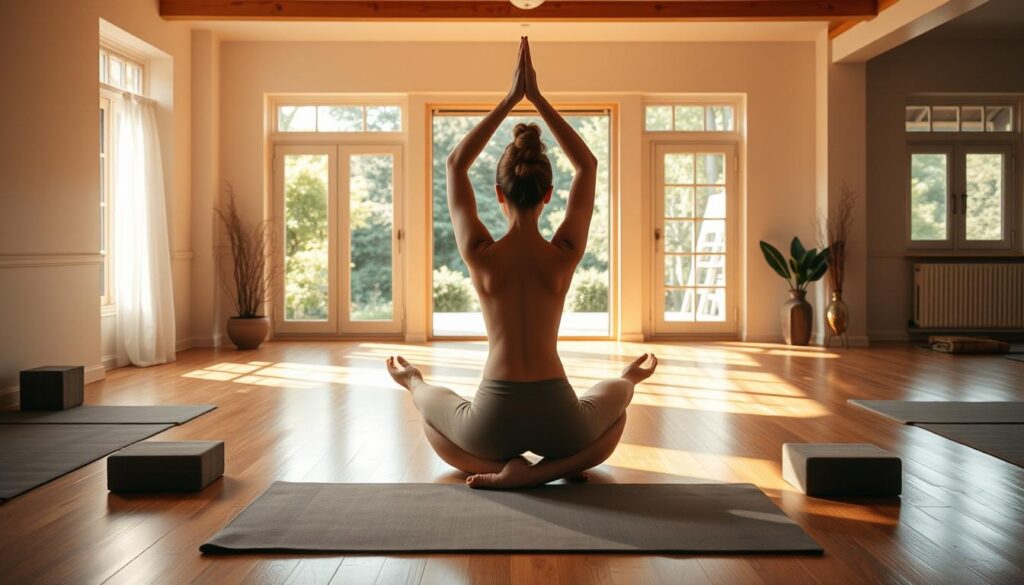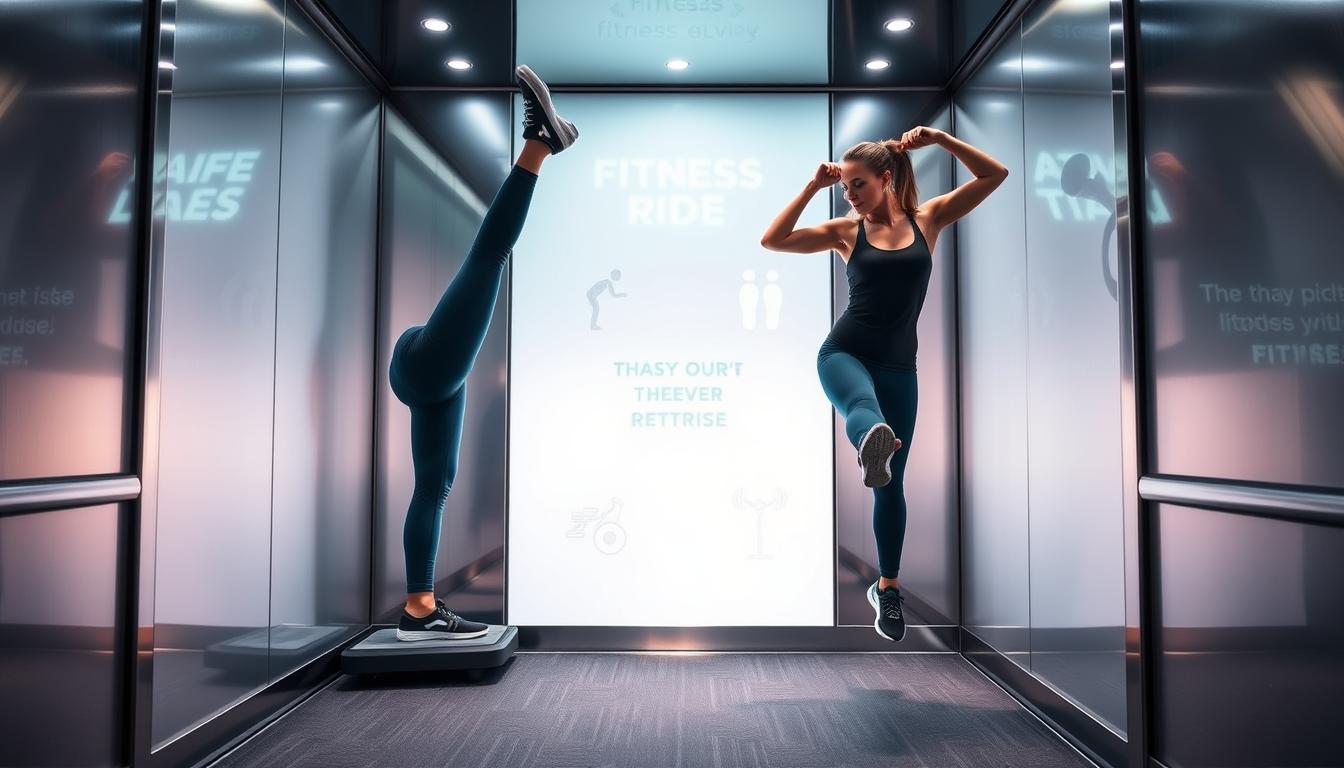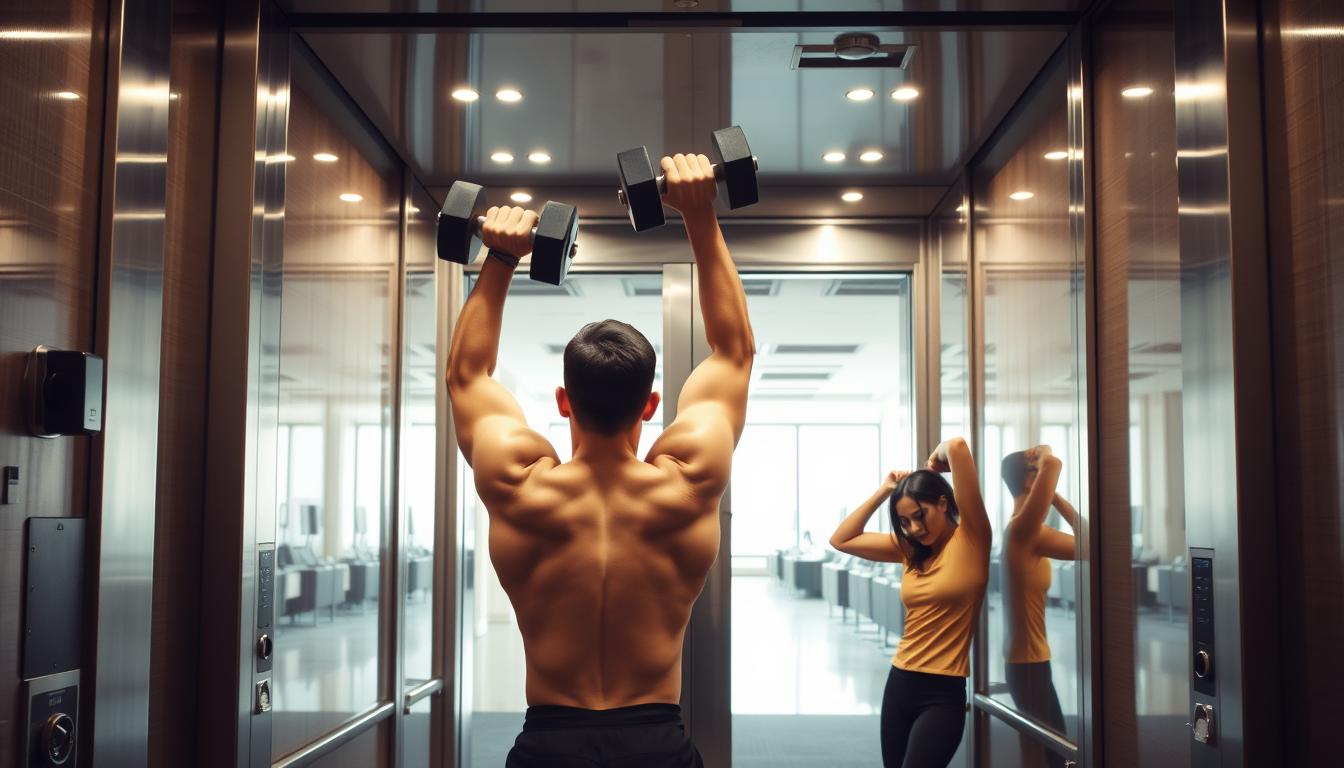Finding time for workouts in a busy work life seems hard. But, short exercises in the office or elevators can up your energy and clear your mind. Just a few simple moves during your day can fight off tiredness and stress.
Maybe it’s a quick stretch or a fast walk upstairs. These little workouts can make you more alert and focused. Giving even a few minutes for movement can change how you feel at work. It can make you feel better all around.
The Importance of Staying Energized
Being energized is key to doing better at work and staying sharp all day. When we’re tired, we can’t focus well, feel more stressed, and our health suffers. Getting regular exercise helps fight these problems by keeping our bodies and minds healthy.
Doing aerobic exercise, like running, for 30 minutes several times a week really helps lift our energy. This kind of workout not only makes us happier but can also help fight off sadness. By finding fun ways to exercise, such as playing a sport or joining a class, we can stick to our exercise plans and keep feeling energized and mentally strong.
Yoga is especially good for lowering stress and sadness. Studies say it can help a lot with mental health, not just with staying fit. Even short, easy exercises done at your desk can help you keep up your energy and think clearer on busy days.
Regular exercise is not just for staying in shape—it makes our work life better too. Research has found that staying active leads to fewer days feeling mentally unwell. When we keep ourselves energized, we are more productive and create a happier workplace.
Understanding Work-Related Stress
Today, work-related stress is a big problem in our fast-moving world. It leads to health issues like joint pain, headaches, fatigue, and stomach trouble. Knowing about these stressors helps us fight them with good stress management skills.
Being active is a key way to lower work-related stress. When we exercise, our brains release endorphins. These are chemicals that make us feel happy and lessen pain. Health experts say we should do 150 minutes of moderate exercise or 75 minutes of harder workouts every week. Making exercise a regular habit can really help manage stress.
Strength training twice a week improves our health and helps with stress. Regular workouts can also lower your heart rate and blood pressure while boosting your immune system. Plus, they can help you sleep better. All these benefits reduce stress’s bad effects on our bodies.
Workplaces with gyms and group classes make it easier for employees to exercise. When bosses join in, it shows they care about their staff’s health. This helps everyone focus on staying fit. It makes the workplace a healthier place for everyone.
Energizing Workouts for Elevators
Many people find it tough to fit fitness into a busy life. Quick workouts can be a great solution. They let you slip exercises into your day without much fuss. Short bursts of activity can boost your health and make you more productive, even on busy days.
Incorporating Exercise into a Busy Schedule
It’s not always easy to find time for the gym with a packed schedule. But you can do simple exercises right in your office, quickly. Here are some you can try:
- Desk Pushups: Doing 10 to 20 of these works your arms and chest and gets your blood flowing.
- Squats: Just 10 squats can work several muscles and only takes a minute.
- Calf Raises: These improve your blood flow and can be done in moments while standing.
- Jumping Jacks: A quick way to pump up your heart rate with 10 to 20 reps.
- Marching in Place: Great for heart health, and easy to do while on a call or on a break.
Benefits of Quick Workouts
Short workouts can be super beneficial. Research shows that even brief activity sessions can:
- Lessen the pain from sitting too long.
- Boost your mood and clear your mind.
- Raise your productivity for the day.
A 5-move circuit workout can be very effective. It should include exercises that work multiple muscles, like:
- Desk Plank to strengthen your core.
- Bicep Curls with any weights you have for upper body strength.
- Triceps Dips on a chair to focus on arms and chest quickly.
- Calf Raises to build strength in your lower legs.
- Sits from squats to improve how you stand and sit.
You can do this circuit a few times in 20 to 30 minutes, making it perfect for busy days. Taking the stairs is another great exercise and burns more calories than sitting. Carrying weights as you go can make it even better.
Stretching: The Quickly Revitalizing Solution
Adding stretching exercises to your daily life can really help you at work. These easy moves can make you feel less tense and more energetic, even if you sit a lot. By doing stretches like the Crescent Stretch and Doorway Stretch, you can wake up your body and stand straighter while fighting the downsides of sitting too much.
Crescent Stretch to Relieve Tension
The Crescent Stretch is great if your upper back and neck feel stiff. It makes you breathe deeply, which helps you relax both your mind and body. To do it, stand up, reach an arm high, and lean to the side. This makes your upper body longer and more flexible.
Doorway Stretch for Upper Body Wellness
The Doorway Stretch is amazing for your chest and shoulders, which you need if you sit at a desk a lot. Stand in a doorway, put your forearms against the wall, and lean forward to feel the stretch. This movement eases tension, which is common in office workers, with 62% having neck pain. Doing these stretches not only lessens tension but makes you feel better at work.
Cardio Boost: Jogging and Walking
Adding cardio like jogging and walking can make you feel more energetic and clear-headed. These exercises are not just good for your body. They make you happy by releasing endorphins, improving your focus and happiness.
Jogging for Mental Clarity
Jogging can make your heart healthy, burn fat, lift your mood, and increase your stamina. Doing it a few times each week can really change your fitness level. Jog for 20-30 minutes, 2-3 times a week to see a big difference. It’s important to wear the right shoes and drink water before and after your run.
Try a 25-minute workout outside. Mix jogging, walking, sprints, and hill climbs for an all-around cardio session.
- Warm-up: 5 minutes of light jogging or walking.
- High-intensity intervals: Alternate 20-second bursts of activity with 10-second rests.
- Recovery: 1 minute of walking or jogging between intervals.
- Cool down: End with 2 minutes of recovery walking and stretching.
The Power of Walking During Office Hours
Going for a walk has lots of benefits. It can cut the risk of heart disease and help keep your weight in check. Walking is great at work because it helps refresh your mind and body. Aim for 150 minutes of walking each week, divided into 30-minute walks.
Moving safely is key. Wear shoes that support your feet well and don’t forget to drink water. Encouraging short walks during the day or having walking meetings can boost energy and make your mind clearer.
Serene Practices: Yoga and Pilates
Yoga and Pilates can energize your day if you add them to your routine. Morning yoga wakes you up, improves your flexibility, and helps you focus. It also calms your mind, getting you ready for a productive day. Pilates focuses on your core strength and stability. It uses careful movements that boost your energy levels.
Morning Yoga to Awaken the Senses
Starting your day with yoga has many benefits. It makes you more flexible by stretching your body. Yoga also uses breath work to reduce stress and help you relax. This gets your energy (prana) flowing and sharpens your focus and mental clarity for the day ahead.
Pilates: Strengthening the Core for Energy
Pilates improves core strength with precise movements. It makes you stable and ups your energy. Exercises like The Hundred and Single-Leg Stretch activate the core and improve coordination. Mixing Pilates and yoga can better your posture. This is great for anyone who sits a lot.

High-Intensity Workouts: Fit for Elevators
High-intensity workouts shine in small spaces, like elevators, and HIIT is a top pick. It combines intense exercises with quick rest times. This mix helps you stay energized all day.
Looking for a quick workout? Try these exercises that fit in small areas:
- Jumping jacks: 30 seconds on, 30 seconds off.
- Bodyweight squats: 40 seconds on, 20 seconds off.
- Mountain climbers: 30 seconds on, 30 seconds off.
- High knees: 45 seconds on, 15 seconds off.
- Plank challenge: 30 seconds on, 30 seconds off.
- Sprint intervals: 20 seconds on, 40 seconds off.
- Bicycle crunches: 45 seconds on, 15 seconds off.
- Burpees: 20 seconds on, 40 seconds off.
Adding these workouts to short breaks makes good use of your time. They keep you strong and active. Studies show 15 minutes of these can drastically improve your health and lengthen your life. Aim for a 7 to 8 effort out of 10 in HIIT for the best results.
From quick lunges to rowing, these exercises boost your heart and resilience. Adding these to daily routines can make elevator rides an exciting fitness boost.
Strength Training: Elevate Your Workout Routine
Adding strength training to your daily exercises boosts energy and well-being. It presents many benefits, making it essential for a balanced routine. You don’t need a lot of time; quick resistance activities can majorly increase your energy for the day.
Benefits of Weightlifting for Energy Levels
Weightlifting keeps lean muscle and reduces fat, leading to better body health and more energy. It also makes bones stronger, lowering osteoporosis risk as you get older. Plus, it speeds up your metabolism, helping you burn more calories.
Beyond the body, strength training lifts your mood, self-esteem, and reduces anxiety. Regular lifting can even keep your mind sharp, improving memory and learning, and protecting against cognitive decline with age.
Short Bursts of Resistance Training
Try short, focused strength sessions each week. Health experts advise working all major muscles twice a week, doing 12 to 15 reps with the right weight. Just 20 to 30 minutes, two or three times a week, can make you stronger and more energetic.
Focus on exercises like squats and bench presses that work several muscle groups at once. This makes your workout more efficient. If you’re short on time, try supersets or drop sets to cut your workout time but still meet your goals.
Conclusion
Adding energetic exercises to our daily life is key to staying alert and productive. Simple moves, like stair climbing, show that small steps can greatly boost our health. This not only keeps the heart healthy but also builds stronger muscles and bones. Plus, it helps keep our weight in check.
Dealing with work stress through quick workouts can make the workplace more lively. Activities like yoga, Pilates, and lifting weights help develop good habits. They clear the mind and make us feel happier. Since these can fit into a busy day, they help us stay active, which is important for our health.
By making physical activity a priority, we gain a lot of benefits from energetic exercises. They not only make us happier and less stressed but also help us lead a healthy, active life. Start adopting these habits to see how much better you can feel, at work and at home.



